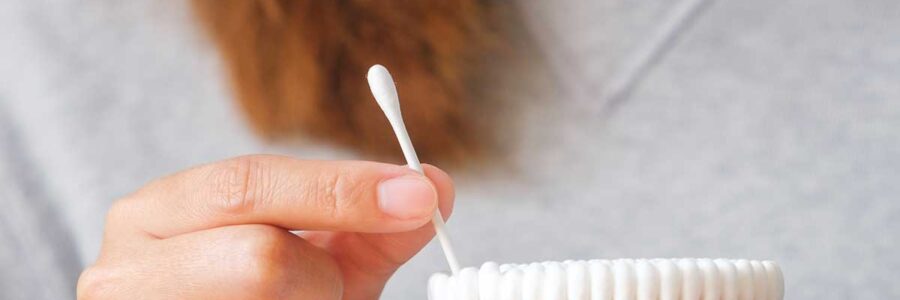Q-Tips are a staple in nearly every home. They’re used for cleaning ears, applying makeup, baby care, first aid, and even household cleaning. But despite their convenience, these small cotton swabs may be exposing you to unnecessary toxins every time you use them.
Most conventional cotton swabs are made using pesticide-treated cotton, synthetic glues, chlorine bleach, and chemical solvents. Since Q-Tips are frequently used in sensitive areas like the ears, nose, eyes, and even on babies’ skin, they become a direct source of chemical exposure. While a single use may not cause immediate harm, repeated exposure over time can contribute to hormone disruption, immune suppression, and an increased toxic burden on the body.
What’s Really in Q-Tips?
Many people assume that Q-Tips are simply made of cotton and paper, but the reality is much more concerning. Conventional cotton swabs often contain:[1]
- Pesticides and herbicides – Cotton is one of the most chemically treated crops in the world. It is commonly sprayed with pesticides like glyphosate, which has been linked to hormone disruption, gut health issues, and even cancer. Because cotton fibers are highly absorbent, these chemicals remain in the cotton even after processing.[2]
- Chlorine bleach residues and dioxins – To achieve their bright white appearance, most cotton swabs are bleached with chlorine, which produces dioxins as a byproduct. Dioxins are among the most toxic pollutants and are linked to immune dysfunction, reproductive issues, and long-term hormone imbalance.
- Polyvinyl acetate and other glues – The cotton tips on many swabs are held together with synthetic adhesives, which can release volatile organic compounds (VOCs) when they come into contact with heat or moisture. These adhesives are commonly used in industrial glues and may be absorbed through the skin with regular use.[3]
- Solvent residues – Cotton fibers undergo chemical processing to remove impurities, but traces of solvents remain in the final product. These chemicals can irritate the skin and increase the body’s overall toxic load.
Because cotton swabs are often used in delicate areas like the ears and eyes, where the skin is thin and highly absorbent, these chemicals can enter the body more easily than through thicker areas of skin.
The Problem with Using Q-Tips for Ear Cleaning
One of the most common uses for Q-Tips is earwax removal, but this habit can actually cause more harm than good. The ear canal is designed to be self-cleaning, and earwax plays an important role in trapping bacteria, dust, and other particles before they reach the inner ear.
Using Q-Tips to remove earwax can lead to:
- Impacted earwax – Instead of removing earwax, Q-Tips tend to push it deeper into the ear canal, creating blockages that can cause hearing loss, discomfort, and infections.[4]
- Eardrum damage – The ear canal is delicate, and inserting a cotton swab too far can cause irritation, minor abrasions, or even puncture the eardrum, leading to pain, tinnitus, or hearing issues.
- Increased risk of infection – Scraping the skin inside the ear can create tiny micro-cuts, allowing bacteria and fungi to enter, leading to infections.[5]
If you experience excessive earwax buildup, a better approach is to use ear drops made with hydrogen peroxide or saline solution, which can naturally soften and remove wax without causing impaction or irritation.
The Best Alternatives to Q-Tips
The good news is that there are safer alternatives to conventional Q-Tips that do not come with the same toxic risks. When choosing cotton swabs, look for ones that are:
- Made with 100 percent organic cotton, which is grown without pesticides or herbicides
- Unbleached or bleached with hydrogen peroxide instead of chlorine to avoid dioxins
- Chlorine-free to reduce unnecessary toxin exposure
- Made with a natural wooden stick instead of plastic or synthetic-coated materials
Brands like Sky Organics offer organic, chlorine-free cotton swabs that are much safer than conventional Q-Tips. While not completely non-toxic, these options significantly reduce the toxic load compared to standard drugstore brands.
For those looking to eliminate disposable swabs altogether, reusable silicone ear picks or bamboo swabs provide a more sustainable, toxin-free alternative that reduces waste and exposure to synthetic chemicals.
Why Small Swaps Like This Matter
Many people focus on avoiding toxins in food, water, and personal care products, but everyday household items like cotton swabs can also be a hidden source of chemical exposure. Since Q-Tips are used frequently, they represent an unnecessary and easily avoidable source of toxins.
Reducing toxic exposure is not about eliminating every possible chemical but about making intentional choices to minimize exposure where possible. Small swaps, like switching to organic, chlorine-free cotton swabs or reusable alternatives, add up over time and help support the body’s detoxification pathways.
Do You Really Need Q-Tips?
At the end of the day, Q-Tips were never designed to be an essential hygiene tool. They are unnecessary for ear cleaning and contain a range of chemicals that contribute to toxin exposure. If you use them for beauty or hygiene purposes, choosing organic cotton swabs or reusable alternatives is a far safer choice.
Making small adjustments to everyday habits can have a meaningful impact on long-term health. Whether it’s avoiding conventional Q-Tips, switching to safer cookware, or eliminating processed foods, each step helps to reduce unnecessary chemical exposure and lighten the body’s toxic burden.
References:
- Nagala, Sidhartha, et al. “Extent of Cotton-Bud Use in Ears.” The British Journal of General Practice, vol. 61, no. 592, Nov. 2011, pp. 662–63.
- Koussé, Jean Noël Dado, et al. “Self-Reported Health Effects of Pesticides among Cotton Farmers from the Central-West Region in Burkina Faso.” Toxicology Reports, vol. 11, Sept. 2023, pp. 273–82.
- Novak, Morana, and Bronwyn Ormsby. “Poly(Vinyl Acetate) Paints: A Literature Review of Material Properties, Ageing Characteristics, and Conservation Challenges.” Polymers, vol. 15, no. 22, Nov. 2023, p. 4348.
- Sevy, Justin O., et al. “Cerumen Impaction Removal.” StatPearls, StatPearls Publishing, 2025.
- Overview: Outer Ear Infection.” InformedHealth.Org [Internet], Institute for Quality and Efficiency in Health Care (IQWiG), 2023.


